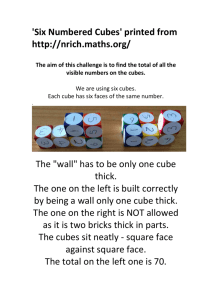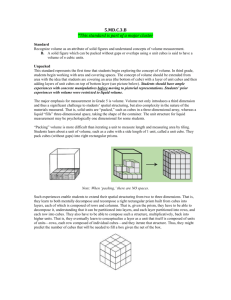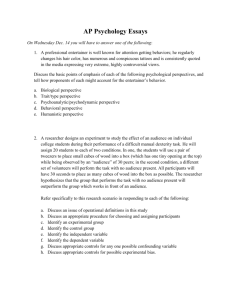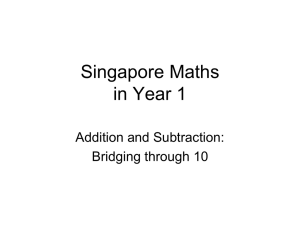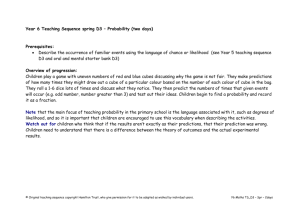cubes every where
advertisement
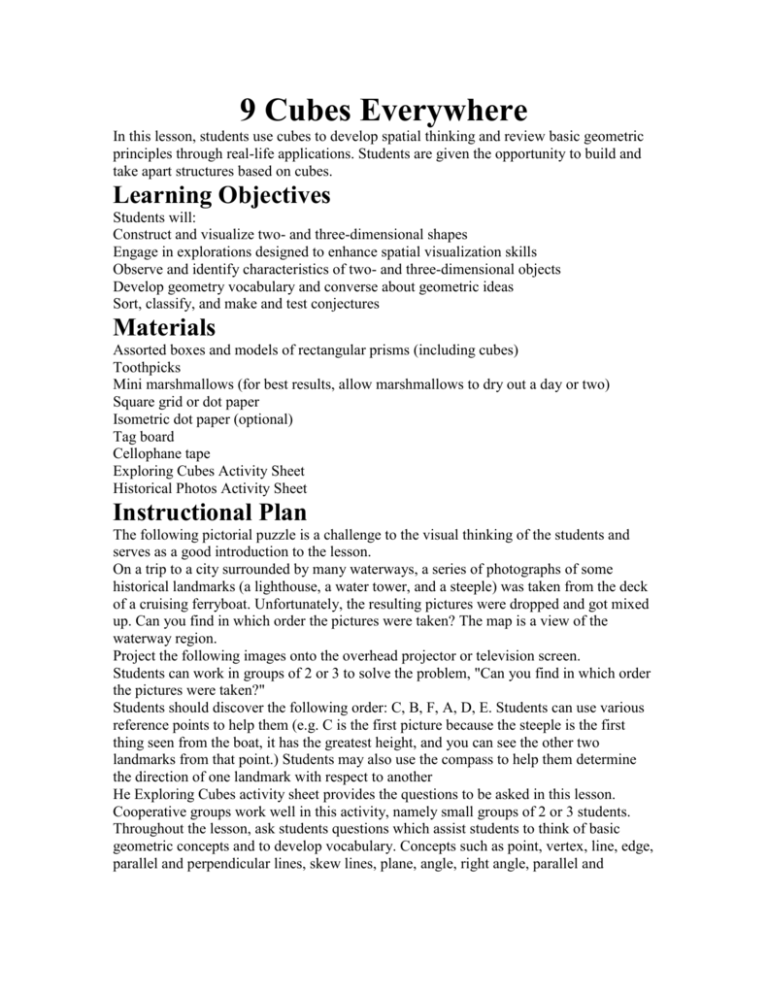
9 Cubes Everywhere In this lesson, students use cubes to develop spatial thinking and review basic geometric principles through real-life applications. Students are given the opportunity to build and take apart structures based on cubes. Learning Objectives Students will: Construct and visualize two- and three-dimensional shapes Engage in explorations designed to enhance spatial visualization skills Observe and identify characteristics of two- and three-dimensional objects Develop geometry vocabulary and converse about geometric ideas Sort, classify, and make and test conjectures Materials Assorted boxes and models of rectangular prisms (including cubes) Toothpicks Mini marshmallows (for best results, allow marshmallows to dry out a day or two) Square grid or dot paper Isometric dot paper (optional) Tag board Cellophane tape Exploring Cubes Activity Sheet Historical Photos Activity Sheet Instructional Plan The following pictorial puzzle is a challenge to the visual thinking of the students and serves as a good introduction to the lesson. On a trip to a city surrounded by many waterways, a series of photographs of some historical landmarks (a lighthouse, a water tower, and a steeple) was taken from the deck of a cruising ferryboat. Unfortunately, the resulting pictures were dropped and got mixed up. Can you find in which order the pictures were taken? The map is a view of the waterway region. Project the following images onto the overhead projector or television screen. Students can work in groups of 2 or 3 to solve the problem, "Can you find in which order the pictures were taken?" Students should discover the following order: C, B, F, A, D, E. Students can use various reference points to help them (e.g. C is the first picture because the steeple is the first thing seen from the boat, it has the greatest height, and you can see the other two landmarks from that point.) Students may also use the compass to help them determine the direction of one landmark with respect to another He Exploring Cubes activity sheet provides the questions to be asked in this lesson. Cooperative groups work well in this activity, namely small groups of 2 or 3 students. Throughout the lesson, ask students questions which assist students to think of basic geometric concepts and to develop vocabulary. Concepts such as point, vertex, line, edge, parallel and perpendicular lines, skew lines, plane, angle, right angle, parallel and perpendicular planes, square, rectangle, diagonal, and so on, naturally arise in student discussions and in response to questions. These activities give students an opportunity to see, touch, and manipulate tangible embodiments of the concepts. They allow students to build visualization skills as they study relationships among attributes of geometric objects and figures. Students might draw some of the networks on tag board and construct cubes and open boxes. Students might make up their own versions of creating a "building" with given front, side, and top views to challenge their classmates. Solutions to the Exploring Cubes activity sheet: The number cube and box of cookies are examples of rectangular prisms. Students will give various examples of objects they have seen. The milk container and rectangular prism are not examples of cubes, because not all 6 faces are congruent. Students should have used 12 toothpicks and 8 marshmallows. Students should see parallel lines (e.g. the toothpicks on the top of the cube in the front and back), and they should see perpendicular lines (e.g. a horizontal toothpick meets at a right angle with a vertical toothpick). Students may view the top face and the bottom face as parallel planes, and they may consider the top face and the front face as perpendicular planes (for example.) Student answers will vary depending on their drawings and the way they labeled the vertices. The first, fourth, and fifth pictures could be a view made from the number cube net shown. 6 squares are needed to form a net for a cube. There are twelve different pentominoes. Pentominoes are not considered "different" if the same figure can be obtained by slide, flip, or turn motions. Eight of the twelve pentominoes can be folded into open boxes (i.e., a cube without a lid). Student answers will vary, depending on the building they draw. 95 cubes were needed to build the design in the figure. Students may use several methods for solving this problem, including actually building the figure and counting the number of cubes used NCTM Standards and Expectations Precisely describe, classify, and understand relationships among types of two- and threedimensional objects using their defining properties. Describe sizes, positions, and orientations of shapes under informal transformations such as flips, turns, slides, and scaling. Recognize and apply geometric ideas and relationships in areas outside the mathematics classroom, such as art, science, and everyday life. Use two-dimensional representations of three-dimensional objects to visualize and solve problems such as those involving surface area and volume. Use visual tools such as networks to represent and solve problems. Draw geometric objects with specified properties, such as side lengths or angle measures




